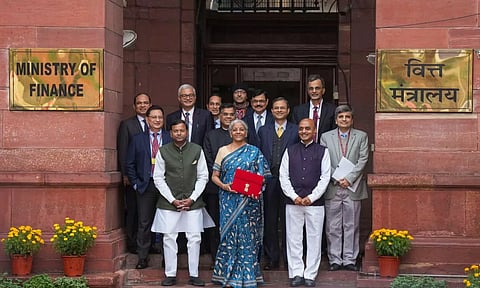

CHENNAI: In what appeared to be a no-brainer exercise in setting the stage for charting out India’s expense sheet after the general elections that are expected to be held between April and May this year, Finance Minister Nirmala Sitharaman presented an interim budget on Thursday, stuck by her forecast of no surprises.
A better part of the 60-minute long speech comprised a recall of the reforms introduced by the BJP-led NDA government since it came into power at the Centre a decade ago. There were salient points of throwback in the budget that was not conspicuous by the absence of poll-focussed freebies.
Laying the groundwork for our transition into a developed economy by 2047, the budget based its action plans on a four-pronged approach targeting the poor or the underserved, women, the youth, and finally the Annadata or farmers.
The government considers as its achievements initiatives like the Direct Benefit Transfer (DBT) scheme which led to savings to the tune of Rs 2.7 lakh crore, credit assistance to 78 lakh street vendors under the PM-SVANidhi programme, and moving as many as 25 crore people out of multi- dimensional poverty.
On youth empowerment, as many as 1.4 cr people were trained under the Skill India mission, while 11.8 crore farmers stood as beneficiaries of direct financial assistance under the PM-Kisan scheme. Disbursement of 30 crore Mudra Yojana loans to women entrepreneurs as well the 28% surge in female enrolment in higher education over the last decade were also honourable mentions in the achievements list.
Training her crosshairs on the aam janata (the common citizen), who happens to form the tax-paying backbone of India, Sitharaman highlighted how over the past five years, the focus of the government has been on improving the taxpayer services. Listing out features including the introduction of faceless assessment and appeal, as well as the updated Income Tax Return (ITR), the new form 26AS and the pre-filing of tax returns, which have made the process simpler, the Finance Minister assured citizens of the government’s commitment to a people-centric leadership model.
There were no changes to the taxation structure, thanks to the realisation of not messing with a working formula when elections are around the corner.
The government seems to be continuing with its thrust on beefing up infrastructure, knowing fully well that this holds the key to increased investments from both within India and beyond. One of the big takeaways of the budget was the 11.1% hike in capex outlay for FY25, at Rs 11.11 lakh crore, a measure that seemed to have piqued the interests of everyone who believes in India’s status as the fastest growing global economy.
Expansion of existing airports and development of new ones, along with the promotion of urban transformation via Metro rail, and the creation of three major economic railway corridor initiatives portends the Centre’s focus on making mobility and logistics seamless in India.
On the macro level, the government is set to borrow a gross of Rs 14.13 trillion in the fiscal year starting April 1, compared with Rs 15.43 trillion for the current fiscal. The fiscal deficit target for FY25 has also been set at 5.1% of the GDP, against 5.8% for FY24 RE which as per many observers is in line with the government’s aggressive fiscal consolidation trajectory.